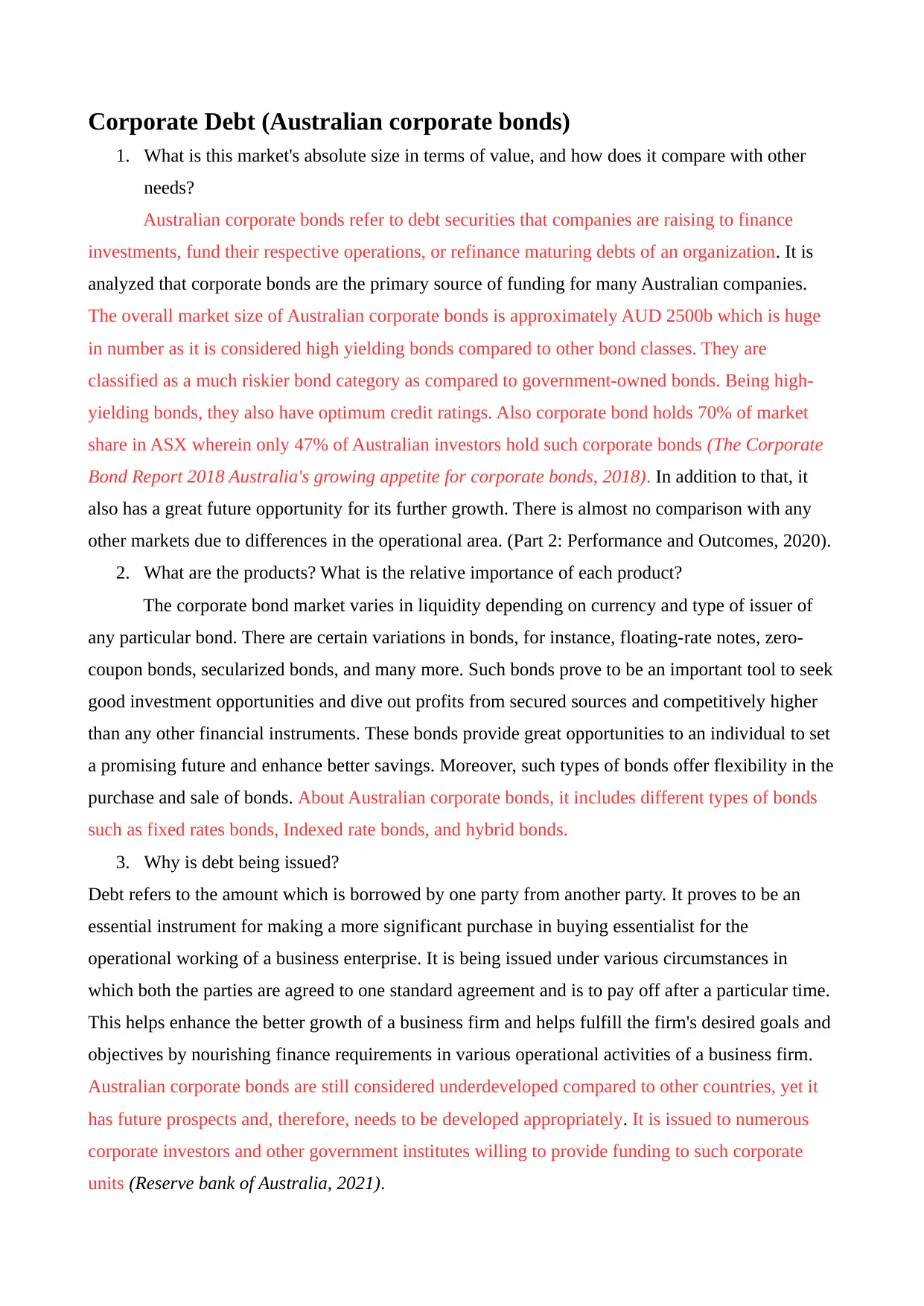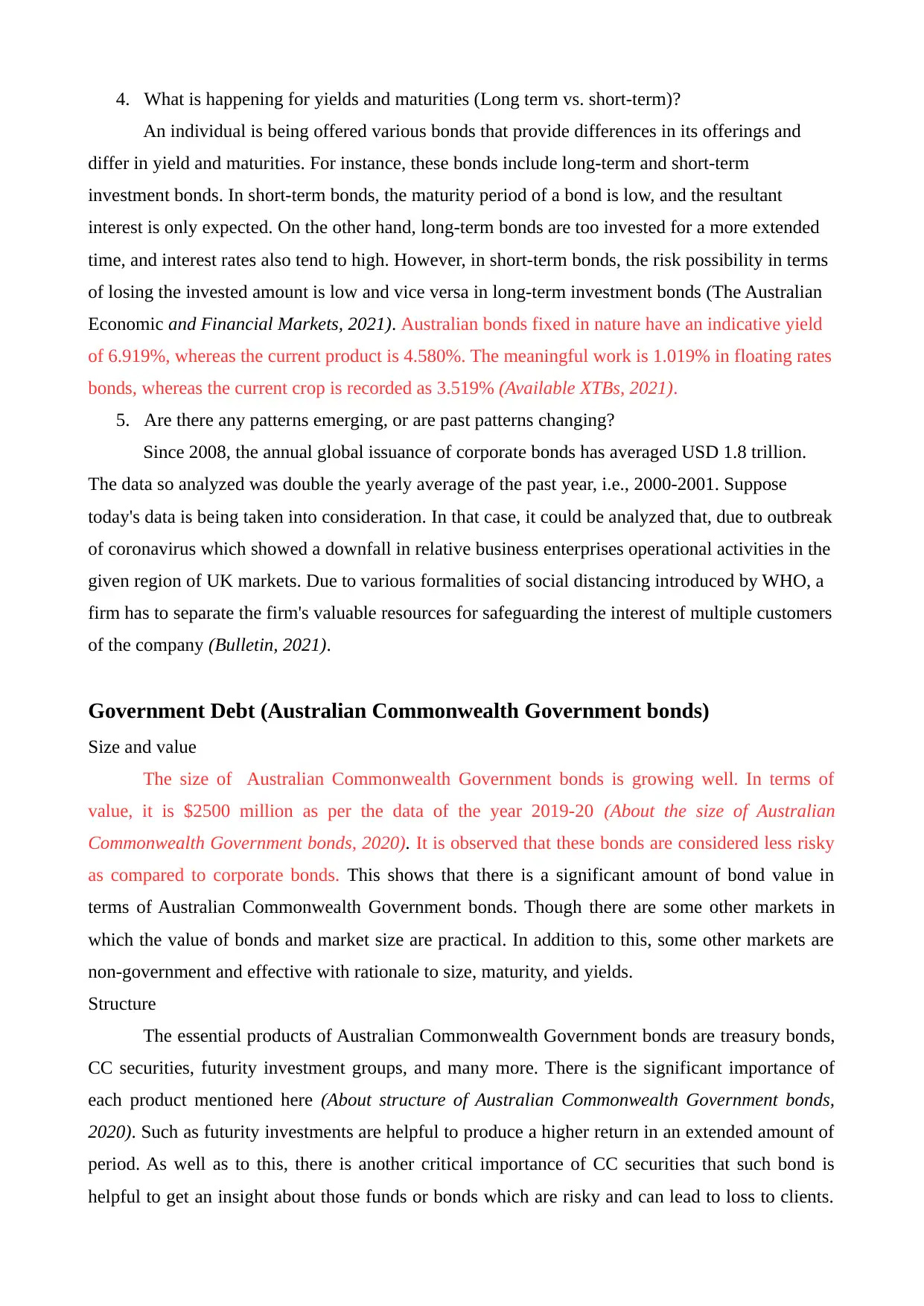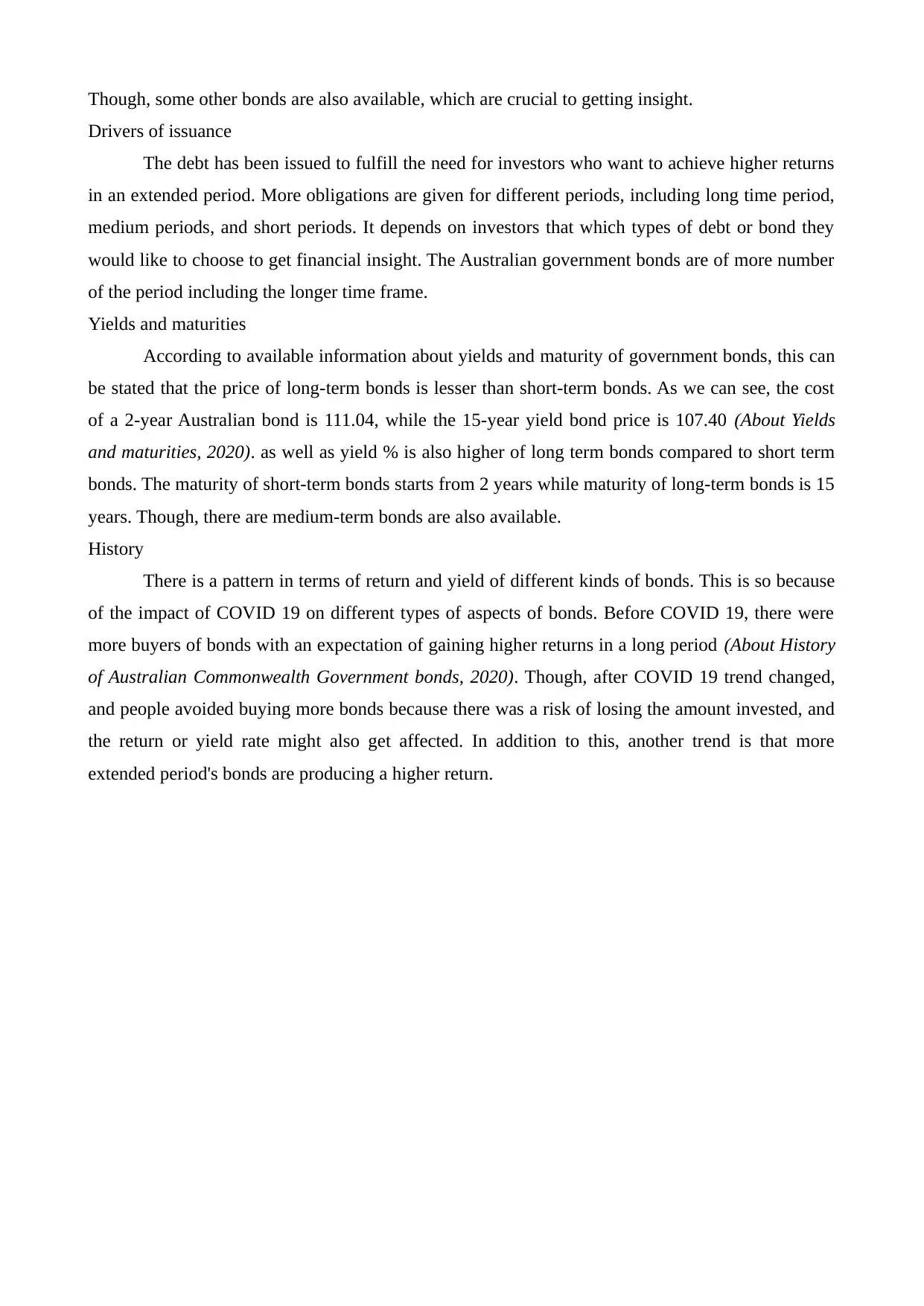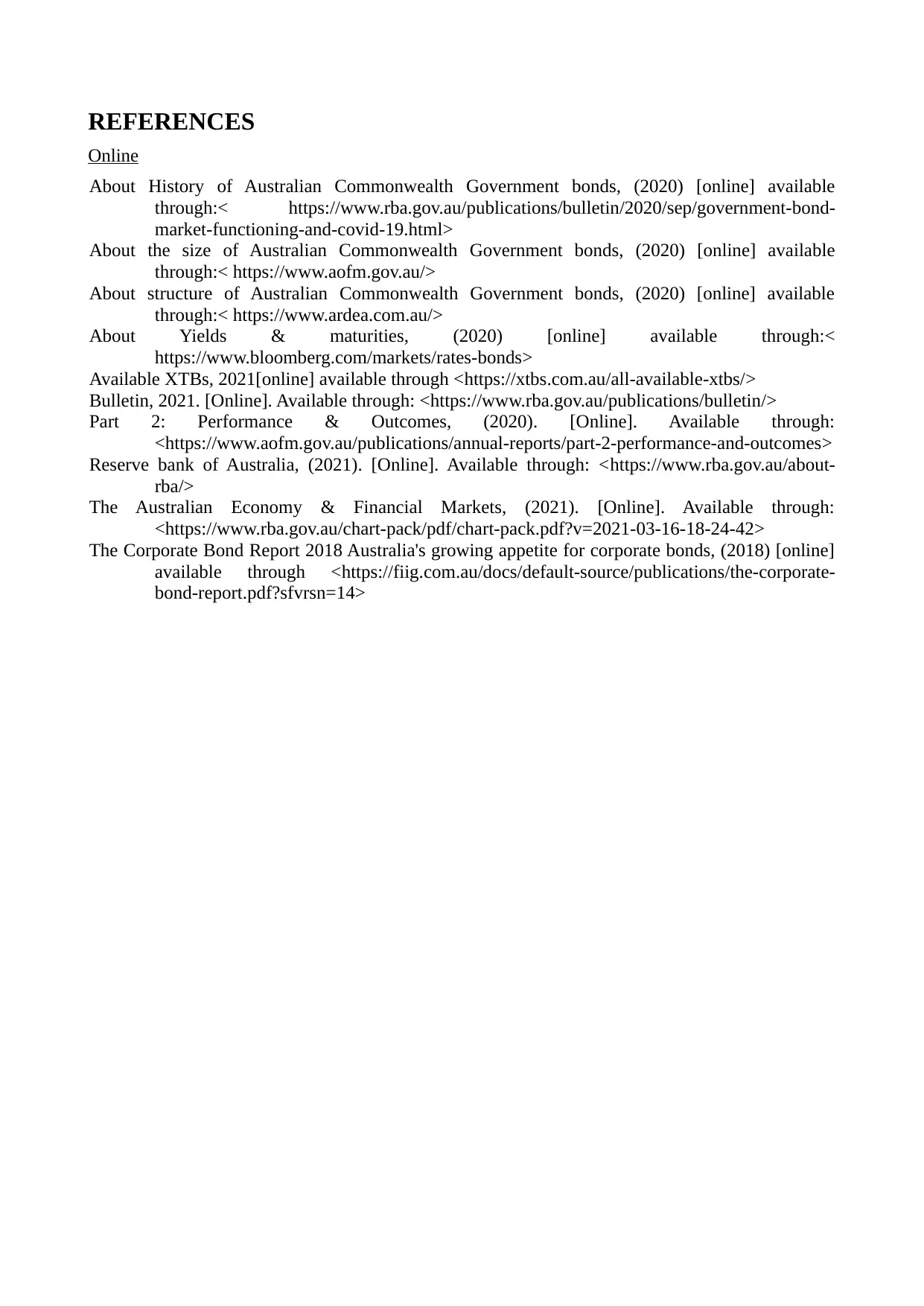Comprehensive Analysis of Australian Corporate and Government Debt
VerifiedAdded on 2022/12/15
|6
|1638
|64
Report
AI Summary
This report provides a comprehensive analysis of the Australian corporate and government debt markets. It begins by examining Australian corporate bonds, detailing their market size, which is approximately AUD 2500 billion, and comparing them to other bond classes, highlighting their higher yield and risk profile. The report explores the various types of corporate bonds, including fixed-rate, indexed-rate, and hybrid bonds, and explains the reasons behind their issuance, primarily to finance investments and refinance debts. It also discusses yield and maturity patterns, differentiating between long-term and short-term bonds. The report then shifts its focus to Australian Commonwealth Government bonds, analyzing their size, structure, and the drivers behind their issuance. It outlines the products available, such as treasury bonds and CC securities, and examines the relationship between yields, maturities, and historical trends, including the impact of the COVID-19 pandemic on bond markets. The report concludes by referencing several online sources for further information on the topic.

AUSTRALIAN CORPORATE
AND GIVERNMENT DEBT
AND GIVERNMENT DEBT
Paraphrase This Document
Need a fresh take? Get an instant paraphrase of this document with our AI Paraphraser

Table of Contents
Corporate Debt (Australian corporate bonds) .....................................................................................3
Government Debt (Australian Commonwealth Government bonds)...................................................4
REFERENCES.....................................................................................................................................6
Corporate Debt (Australian corporate bonds) .....................................................................................3
Government Debt (Australian Commonwealth Government bonds)...................................................4
REFERENCES.....................................................................................................................................6

Corporate Debt (Australian corporate bonds)
1. What is this market's absolute size in terms of value, and how does it compare with other
needs?
Australian corporate bonds refer to debt securities that companies are raising to finance
investments, fund their respective operations, or refinance maturing debts of an organization. It is
analyzed that corporate bonds are the primary source of funding for many Australian companies.
The overall market size of Australian corporate bonds is approximately AUD 2500b which is huge
in number as it is considered high yielding bonds compared to other bond classes. They are
classified as a much riskier bond category as compared to government-owned bonds. Being high-
yielding bonds, they also have optimum credit ratings. Also corporate bond holds 70% of market
share in ASX wherein only 47% of Australian investors hold such corporate bonds (The Corporate
Bond Report 2018 Australia's growing appetite for corporate bonds, 2018). In addition to that, it
also has a great future opportunity for its further growth. There is almost no comparison with any
other markets due to differences in the operational area. (Part 2: Performance and Outcomes, 2020).
2. What are the products? What is the relative importance of each product?
The corporate bond market varies in liquidity depending on currency and type of issuer of
any particular bond. There are certain variations in bonds, for instance, floating-rate notes, zero-
coupon bonds, secularized bonds, and many more. Such bonds prove to be an important tool to seek
good investment opportunities and dive out profits from secured sources and competitively higher
than any other financial instruments. These bonds provide great opportunities to an individual to set
a promising future and enhance better savings. Moreover, such types of bonds offer flexibility in the
purchase and sale of bonds. About Australian corporate bonds, it includes different types of bonds
such as fixed rates bonds, Indexed rate bonds, and hybrid bonds.
3. Why is debt being issued?
Debt refers to the amount which is borrowed by one party from another party. It proves to be an
essential instrument for making a more significant purchase in buying essentialist for the
operational working of a business enterprise. It is being issued under various circumstances in
which both the parties are agreed to one standard agreement and is to pay off after a particular time.
This helps enhance the better growth of a business firm and helps fulfill the firm's desired goals and
objectives by nourishing finance requirements in various operational activities of a business firm.
Australian corporate bonds are still considered underdeveloped compared to other countries, yet it
has future prospects and, therefore, needs to be developed appropriately. It is issued to numerous
corporate investors and other government institutes willing to provide funding to such corporate
units (Reserve bank of Australia, 2021).
1. What is this market's absolute size in terms of value, and how does it compare with other
needs?
Australian corporate bonds refer to debt securities that companies are raising to finance
investments, fund their respective operations, or refinance maturing debts of an organization. It is
analyzed that corporate bonds are the primary source of funding for many Australian companies.
The overall market size of Australian corporate bonds is approximately AUD 2500b which is huge
in number as it is considered high yielding bonds compared to other bond classes. They are
classified as a much riskier bond category as compared to government-owned bonds. Being high-
yielding bonds, they also have optimum credit ratings. Also corporate bond holds 70% of market
share in ASX wherein only 47% of Australian investors hold such corporate bonds (The Corporate
Bond Report 2018 Australia's growing appetite for corporate bonds, 2018). In addition to that, it
also has a great future opportunity for its further growth. There is almost no comparison with any
other markets due to differences in the operational area. (Part 2: Performance and Outcomes, 2020).
2. What are the products? What is the relative importance of each product?
The corporate bond market varies in liquidity depending on currency and type of issuer of
any particular bond. There are certain variations in bonds, for instance, floating-rate notes, zero-
coupon bonds, secularized bonds, and many more. Such bonds prove to be an important tool to seek
good investment opportunities and dive out profits from secured sources and competitively higher
than any other financial instruments. These bonds provide great opportunities to an individual to set
a promising future and enhance better savings. Moreover, such types of bonds offer flexibility in the
purchase and sale of bonds. About Australian corporate bonds, it includes different types of bonds
such as fixed rates bonds, Indexed rate bonds, and hybrid bonds.
3. Why is debt being issued?
Debt refers to the amount which is borrowed by one party from another party. It proves to be an
essential instrument for making a more significant purchase in buying essentialist for the
operational working of a business enterprise. It is being issued under various circumstances in
which both the parties are agreed to one standard agreement and is to pay off after a particular time.
This helps enhance the better growth of a business firm and helps fulfill the firm's desired goals and
objectives by nourishing finance requirements in various operational activities of a business firm.
Australian corporate bonds are still considered underdeveloped compared to other countries, yet it
has future prospects and, therefore, needs to be developed appropriately. It is issued to numerous
corporate investors and other government institutes willing to provide funding to such corporate
units (Reserve bank of Australia, 2021).
⊘ This is a preview!⊘
Do you want full access?
Subscribe today to unlock all pages.

Trusted by 1+ million students worldwide

4. What is happening for yields and maturities (Long term vs. short-term)?
An individual is being offered various bonds that provide differences in its offerings and
differ in yield and maturities. For instance, these bonds include long-term and short-term
investment bonds. In short-term bonds, the maturity period of a bond is low, and the resultant
interest is only expected. On the other hand, long-term bonds are too invested for a more extended
time, and interest rates also tend to high. However, in short-term bonds, the risk possibility in terms
of losing the invested amount is low and vice versa in long-term investment bonds (The Australian
Economic and Financial Markets, 2021). Australian bonds fixed in nature have an indicative yield
of 6.919%, whereas the current product is 4.580%. The meaningful work is 1.019% in floating rates
bonds, whereas the current crop is recorded as 3.519% (Available XTBs, 2021).
5. Are there any patterns emerging, or are past patterns changing?
Since 2008, the annual global issuance of corporate bonds has averaged USD 1.8 trillion.
The data so analyzed was double the yearly average of the past year, i.e., 2000-2001. Suppose
today's data is being taken into consideration. In that case, it could be analyzed that, due to outbreak
of coronavirus which showed a downfall in relative business enterprises operational activities in the
given region of UK markets. Due to various formalities of social distancing introduced by WHO, a
firm has to separate the firm's valuable resources for safeguarding the interest of multiple customers
of the company (Bulletin, 2021).
Government Debt (Australian Commonwealth Government bonds)
Size and value
The size of Australian Commonwealth Government bonds is growing well. In terms of
value, it is $2500 million as per the data of the year 2019-20 (About the size of Australian
Commonwealth Government bonds, 2020). It is observed that these bonds are considered less risky
as compared to corporate bonds. This shows that there is a significant amount of bond value in
terms of Australian Commonwealth Government bonds. Though there are some other markets in
which the value of bonds and market size are practical. In addition to this, some other markets are
non-government and effective with rationale to size, maturity, and yields.
Structure
The essential products of Australian Commonwealth Government bonds are treasury bonds,
CC securities, futurity investment groups, and many more. There is the significant importance of
each product mentioned here (About structure of Australian Commonwealth Government bonds,
2020). Such as futurity investments are helpful to produce a higher return in an extended amount of
period. As well as to this, there is another critical importance of CC securities that such bond is
helpful to get an insight about those funds or bonds which are risky and can lead to loss to clients.
An individual is being offered various bonds that provide differences in its offerings and
differ in yield and maturities. For instance, these bonds include long-term and short-term
investment bonds. In short-term bonds, the maturity period of a bond is low, and the resultant
interest is only expected. On the other hand, long-term bonds are too invested for a more extended
time, and interest rates also tend to high. However, in short-term bonds, the risk possibility in terms
of losing the invested amount is low and vice versa in long-term investment bonds (The Australian
Economic and Financial Markets, 2021). Australian bonds fixed in nature have an indicative yield
of 6.919%, whereas the current product is 4.580%. The meaningful work is 1.019% in floating rates
bonds, whereas the current crop is recorded as 3.519% (Available XTBs, 2021).
5. Are there any patterns emerging, or are past patterns changing?
Since 2008, the annual global issuance of corporate bonds has averaged USD 1.8 trillion.
The data so analyzed was double the yearly average of the past year, i.e., 2000-2001. Suppose
today's data is being taken into consideration. In that case, it could be analyzed that, due to outbreak
of coronavirus which showed a downfall in relative business enterprises operational activities in the
given region of UK markets. Due to various formalities of social distancing introduced by WHO, a
firm has to separate the firm's valuable resources for safeguarding the interest of multiple customers
of the company (Bulletin, 2021).
Government Debt (Australian Commonwealth Government bonds)
Size and value
The size of Australian Commonwealth Government bonds is growing well. In terms of
value, it is $2500 million as per the data of the year 2019-20 (About the size of Australian
Commonwealth Government bonds, 2020). It is observed that these bonds are considered less risky
as compared to corporate bonds. This shows that there is a significant amount of bond value in
terms of Australian Commonwealth Government bonds. Though there are some other markets in
which the value of bonds and market size are practical. In addition to this, some other markets are
non-government and effective with rationale to size, maturity, and yields.
Structure
The essential products of Australian Commonwealth Government bonds are treasury bonds,
CC securities, futurity investment groups, and many more. There is the significant importance of
each product mentioned here (About structure of Australian Commonwealth Government bonds,
2020). Such as futurity investments are helpful to produce a higher return in an extended amount of
period. As well as to this, there is another critical importance of CC securities that such bond is
helpful to get an insight about those funds or bonds which are risky and can lead to loss to clients.
Paraphrase This Document
Need a fresh take? Get an instant paraphrase of this document with our AI Paraphraser

Though, some other bonds are also available, which are crucial to getting insight.
Drivers of issuance
The debt has been issued to fulfill the need for investors who want to achieve higher returns
in an extended period. More obligations are given for different periods, including long time period,
medium periods, and short periods. It depends on investors that which types of debt or bond they
would like to choose to get financial insight. The Australian government bonds are of more number
of the period including the longer time frame.
Yields and maturities
According to available information about yields and maturity of government bonds, this can
be stated that the price of long-term bonds is lesser than short-term bonds. As we can see, the cost
of a 2-year Australian bond is 111.04, while the 15-year yield bond price is 107.40 (About Yields
and maturities, 2020). as well as yield % is also higher of long term bonds compared to short term
bonds. The maturity of short-term bonds starts from 2 years while maturity of long-term bonds is 15
years. Though, there are medium-term bonds are also available.
History
There is a pattern in terms of return and yield of different kinds of bonds. This is so because
of the impact of COVID 19 on different types of aspects of bonds. Before COVID 19, there were
more buyers of bonds with an expectation of gaining higher returns in a long period (About History
of Australian Commonwealth Government bonds, 2020). Though, after COVID 19 trend changed,
and people avoided buying more bonds because there was a risk of losing the amount invested, and
the return or yield rate might also get affected. In addition to this, another trend is that more
extended period's bonds are producing a higher return.
Drivers of issuance
The debt has been issued to fulfill the need for investors who want to achieve higher returns
in an extended period. More obligations are given for different periods, including long time period,
medium periods, and short periods. It depends on investors that which types of debt or bond they
would like to choose to get financial insight. The Australian government bonds are of more number
of the period including the longer time frame.
Yields and maturities
According to available information about yields and maturity of government bonds, this can
be stated that the price of long-term bonds is lesser than short-term bonds. As we can see, the cost
of a 2-year Australian bond is 111.04, while the 15-year yield bond price is 107.40 (About Yields
and maturities, 2020). as well as yield % is also higher of long term bonds compared to short term
bonds. The maturity of short-term bonds starts from 2 years while maturity of long-term bonds is 15
years. Though, there are medium-term bonds are also available.
History
There is a pattern in terms of return and yield of different kinds of bonds. This is so because
of the impact of COVID 19 on different types of aspects of bonds. Before COVID 19, there were
more buyers of bonds with an expectation of gaining higher returns in a long period (About History
of Australian Commonwealth Government bonds, 2020). Though, after COVID 19 trend changed,
and people avoided buying more bonds because there was a risk of losing the amount invested, and
the return or yield rate might also get affected. In addition to this, another trend is that more
extended period's bonds are producing a higher return.

REFERENCES
Online
About History of Australian Commonwealth Government bonds, (2020) [online] available
through:< https://www.rba.gov.au/publications/bulletin/2020/sep/government-bond-
market-functioning-and-covid-19.html>
About the size of Australian Commonwealth Government bonds, (2020) [online] available
through:< https://www.aofm.gov.au/>
About structure of Australian Commonwealth Government bonds, (2020) [online] available
through:< https://www.ardea.com.au/>
About Yields & maturities, (2020) [online] available through:<
https://www.bloomberg.com/markets/rates-bonds>
Available XTBs, 2021[online] available through <https://xtbs.com.au/all-available-xtbs/>
Bulletin, 2021. [Online]. Available through: <https://www.rba.gov.au/publications/bulletin/>
Part 2: Performance & Outcomes, (2020). [Online]. Available through:
<https://www.aofm.gov.au/publications/annual-reports/part-2-performance-and-outcomes>
Reserve bank of Australia, (2021). [Online]. Available through: <https://www.rba.gov.au/about-
rba/>
The Australian Economy & Financial Markets, (2021). [Online]. Available through:
<https://www.rba.gov.au/chart-pack/pdf/chart-pack.pdf?v=2021-03-16-18-24-42>
The Corporate Bond Report 2018 Australia's growing appetite for corporate bonds, (2018) [online]
available through <https://fiig.com.au/docs/default-source/publications/the-corporate-
bond-report.pdf?sfvrsn=14>
Online
About History of Australian Commonwealth Government bonds, (2020) [online] available
through:< https://www.rba.gov.au/publications/bulletin/2020/sep/government-bond-
market-functioning-and-covid-19.html>
About the size of Australian Commonwealth Government bonds, (2020) [online] available
through:< https://www.aofm.gov.au/>
About structure of Australian Commonwealth Government bonds, (2020) [online] available
through:< https://www.ardea.com.au/>
About Yields & maturities, (2020) [online] available through:<
https://www.bloomberg.com/markets/rates-bonds>
Available XTBs, 2021[online] available through <https://xtbs.com.au/all-available-xtbs/>
Bulletin, 2021. [Online]. Available through: <https://www.rba.gov.au/publications/bulletin/>
Part 2: Performance & Outcomes, (2020). [Online]. Available through:
<https://www.aofm.gov.au/publications/annual-reports/part-2-performance-and-outcomes>
Reserve bank of Australia, (2021). [Online]. Available through: <https://www.rba.gov.au/about-
rba/>
The Australian Economy & Financial Markets, (2021). [Online]. Available through:
<https://www.rba.gov.au/chart-pack/pdf/chart-pack.pdf?v=2021-03-16-18-24-42>
The Corporate Bond Report 2018 Australia's growing appetite for corporate bonds, (2018) [online]
available through <https://fiig.com.au/docs/default-source/publications/the-corporate-
bond-report.pdf?sfvrsn=14>
⊘ This is a preview!⊘
Do you want full access?
Subscribe today to unlock all pages.

Trusted by 1+ million students worldwide
1 out of 6
Related Documents
Your All-in-One AI-Powered Toolkit for Academic Success.
+13062052269
info@desklib.com
Available 24*7 on WhatsApp / Email
![[object Object]](/_next/static/media/star-bottom.7253800d.svg)
Unlock your academic potential
Copyright © 2020–2025 A2Z Services. All Rights Reserved. Developed and managed by ZUCOL.





